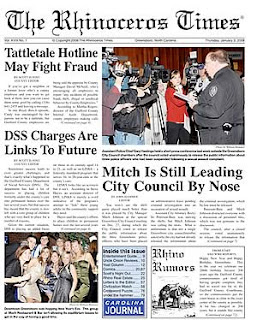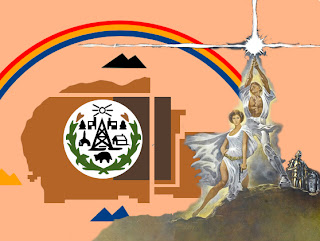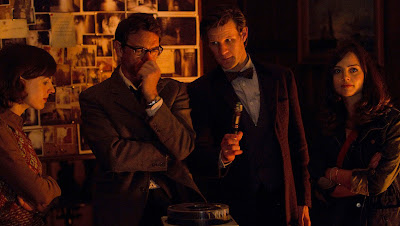 |
Icon of Jesus Christ on the ceiling of Holy Trinity Greek Orthodox Church,
Roanoke, Virginia |
What is "church"? Jesus told Peter that he was "the Rock" and upon it "I will build My church".
My Catholic brethren hold that Jesus was entrusting Peter and his predecessors as the exemplars and leaders of the church. There are others who contend that Jesus was speaking of Peter's faith, and how such faith would be the foundation of His body upon this earth.
My personal understanding of "the church" has grown and developed in recent years, especially as I have visited the congregations of brothers and sisters in Christ with whom I share the faith, but also have differing perspectives about that faith. There are some who will claim that such divisions do not represent true Christianity, but I disagree. In fact, I don't believe that "denominations" are a bad thing at all. There is even biblical precedent for them. The seven churches of Asia Minor we read about in the Book of Revelation were as unlike from each other as there might possibly be. And yet, Christ did not cast any of them from His sight. There were some He praised and some He castigated, but they were still counted as being of His flock.
It was the coincidental visits by two dear friends which opened my eyes to a beautiful truth. One is a Baptist minister and the other is a true renaissance man of many skills. It was the latter who noted, as we discussed some spiritual matters, that "we're having church right now". Because as Jesus taught His disciples, "where two or three are gathered in My name, there I am also".
That is what "church" is. A gathering of imperfect people in the name of the One who is perfect and covers all our transgressions. And if we see Him in different ways but still strive to cast our eyes upon Him, I've no reason to believe that His grace isn't beyond such minor incongruencies inherent to our carnal minds.
Yet even so, the professionally-trained historian of my nature wonders: where is the long, long line of fellowship through the ages, before and beyond the
ekklesia of our sanctuaries and meeting houses and little gatherings of two or three? Is there such a thing, even?
A week and a half ago my girlfriend Kristen and I visited a Greek Orthodox church: something which I had never done before. Kristen is pursuing a master's degree and one of her classes requires attending the worship services of a culture not one's own. There are a number of congregations in the Roanoke area which fit that criteria. In the end, she chose the Greek Orthodox one. She had to visit it twice and I went with her the second time.
It was a worship experience unlike anything that I had ever had the pleasure of watching. Indeed, more than a week later and I am still trying to take in the beauty, the tenderness and the devotion that I witnessed.
We arrived at
Holy Trinity Greek Orthodox Church on Huntington Boulevard in Roanoke at around 9:30 in the morning. A gentleman greeted us in the narthex, and Kristen introduced us to him. The first thing that I noticed was a kind of table to our right, laden with votive candles (I'm assuming that's what they are called in Orthodoxy). Many were lit and placed standing in a rectangular area of white sand, at the center of which was drawn, as with a finger, a Greek-styled cross. I didn't ask anything about it but it is something that has stuck with me since.
Incidentally, it is the narthex where Orthodox baptisms take place. Why? Because it is by baptism which one enters into the church. And fittingly, it is through the narthex which one comes into worship
as a church.
Kristen and I took seats in the furthest pew at the back of the sanctuary, and settled in to watch. But I use the phrase "settled in" lightly. It turns out that in Orthodox worship, if you are at all able to, you stand up... a
lot! And that's what we did
for most of the two and a half hours that we were there for.
Obviously for those coming from the Methodist, Baptist or similar persuasion, this is something rather unheard of.
(And speaking of that: I met three people at Holy Trinity who are former Baptists. One of them was among the ministers praying the Matins. More on those in a sec, but I thought that was rather intriguing that there were quite a number of what are considered "Protestants" who have since become Orthodox, and these are far from the only ones. For reasons which again, I shall examine shortly...)
 |
| Prayer Matins at Holy Trinity Greek Orthodox Church |
So we were standing and the
Matins were already well underway This is... well, in my mind this is the primary part of Orthodox congregational worship. It is a continuous time of prayers and chants - in our English vernacular as well as in Greek - which I saw three or five black-garbed ministers intoning at a podium toward the front of the sanctuary. Kristen had asked me to keep my photography to a bare minimum and I agreed to do so... but even if she hadn't asked, I think I would have done so anyway. And it was only because I wanted to write about it for this blog that I even felt a need to take pictures at all. And why is that?
Because I was... and I still am... overwhelmed by the sense of wonder and majesty and piety and devotion that I saw and heard from the two and a half hours we spent there. Most of that was because of the Matins. I cannot recall ever hearing prayers so beautifully offered up to God. They were praise and appeals and music and much more all in one, made melody from the heart.
(Something I noticed during the service and mentioned to Kristen: at no time did we see any musical instruments. The Matins, if they are considered "singing" from our modern perspective, are strictly
a cappella. Musical instruments are a fairly modern innovation going back four or five hundred years or so, but Orthodoxy has never found a need for them.)
The reason for that is something that, as a student of history, I found most intriguing: that Orthodoxy is perhaps the
one organized church which can claim a continuous, unbroken thread of form and worship to the times of the earliest New Testament-era Christians in the region of Palestine.
Let me be clear on something: my Orthodox brethren
do not and have
never claimed to be "the one true church". In fact, such a boast would be completely alien, even sacrilegious to Orthodoxy! Their tenet could be summed up as such: "Christians only, but not the only Christians". There were certainly others who did not necessarily subscribe to "Orthodox" style (history indicates that the churches in India founded by Thomas the Apostle were independent of anything recognizable by European standards, as were those of Ethiopia which traced their beginnings to the eunuch converted by Philip recorded in Acts chapter 8). Rather, Orthodoxy is a chain of followers of Christ sharing a singular form of worship, one end of which is what we witness today and at the furthest end, the Apostolic Fathers.
And there is considerable historical evidence for this. I found it...
most fascinating. And I can readily understand the appeal that Orthodoxy has for many believers. For those searching for worship of Christ in its purest and most native form, there is a lot of appeal to be found in Orthodoxy.
The Matins went on until noon. People came into the sanctuary to pray (and to stand of course) and then...
they left. After however long their hearts led them. Ya see, in the Orthodox church there isn't a set time of worship where everyone comes in and prays and worships and listens to sermons together. It's a much more individual and reflective experience than what many of us are accustomed to. And I can understand the appeal of that, also. It's the thing about Orthodoxy that I find most appealing to myself, I must admit. Prayer and devotion to God should be a matter between the person and the Lord. And that isn't glossed-over in Orthodoxy. It is, instead, one of the foremost items of worship.
At the front of the sanctuary there was a partitioned-off area with three open doors. This is intended to be analogous to the Holy Place of the Temple in Jerusalem, and the Tabernacle before it. Only the priests and their attendants are allowed in this area, but it is completely visible from the sanctuary. This is where the altar is placed, and upon it the church's copy of the Holy Bible: something which is maintained in special reverence and sanctity. At least twice, the priests brought the Bible out and carried it around the sanctuary. When this happens, everyone turns to face the Bible. The acolyte parading in front of it walks backwards so that his own face is turned toward it. So while standing Kristen and I and everyone else did a complete 360-degree turn.
Now, I gotta mention this, because it's become something that a lot of people have found, well... comical. While the Matins are going on the priests are carrying a censure of incense around the altar. This incense was some
strong stuff. I mean,
REALLY strong. Later we learned that it was probably burning sandalwood with roses. A priest carries the censure and that incense before the Bible as it's being carried around the sanctuary. And here is where things got funny...
I don't know what it was about that incense, and I did
NOT see anyone else reacting this way.
PLEASE remember that! But as for me personally, well... that smoke smelled incredibly lovely but it also made me high as a kite. I mean it: for the first time in my life I felt stoned (I've never done marijuana or cocaine or any of that junk so I've no way to compare it but... there it is). How much so? Kristen saw me nearly stagger while standing. And then there was the icon of Christ on the cross on the ceiling: so help me, I saw Him waving His arms up and down.
I'm absolutely certain that it was an allergic reaction. I'm no doubt in a solid minority of those who might have that happen to. And it's not the same incense that they use anyway: one person told me that there is a variety that gets used. It wouldn't be the first time that something smoky has had an affect on me either: at a Boy Scout event in Indiana years ago the smoke needed to illuminate a laser show caused a reaction which sent me to the hospital a few days later. So now I know I've a quirky allergy or something (along with all my other problems but anyhoo...)
At around 11:30 we heard a homily that I enjoyed immensely. It was about how the worship in the sanctuary stretches across space and time, back to the early Christians. That in our worship we truly are one body of believers in Christ. The
ekklesia as the body of Christ is something unbound and unfazed by geography or politics or the wear and tear of eons. It is a mystical communion with those who have come before, and with those who will come after us.
Speaking of communion, this was the final part of the service. In Orthodoxy, the Eucharist is reserved only for those baptized and joined to the church. I understand why, and it is something I learned from a Catholic friend: that those partaking in communion must examine themselves before God, and find themselves worthy to share in the sacrament. It's not meant to be something exclusive to Orthodoxy for exclusivity's sake. Rather, it is a spiritual "safety mechanism" for the individual believer. The Apostle Paul taught that we must be sure of our worthiness to take part in the communion, and in Orthodoxy (as well as Catholicism) this is a matter of grave policy. However, there is also a "communion" of sorts with visitors not of the Orthodox persuasion. The bread used in the Eucharist is deemed "consecrated bread". But after the Eucharist is over, the non-Orthodox are offered the same bread... which is now considered to be "blessed bread". I found this to be quite a joyful and unifying experience: that though Kristen and I were not Orthodox, we were still considered to be friends and brethren in the larger fellowship of Christ.
I would be remiss if I did not write about the Orthodox practice of kissing the Bible and the icons. This is a sign of faith and devotion to God. The Bible, I think many Christians will understand why. But what of the icons: those beautifully painted depictions of Christ, Mary, the Apostles and the events of their lives?
Although we were never told so during our time at Holy Trinity, I think I can understand why, and it has to do with that "unbroken apostolic chain" spoken of earlier. The premise of an icon is that it "transfers" from one to another. That is, an icon produced in the present day has been presented and touched to an icon painted earlier. And that icon has likewise touched an earlier icon. And so on and so on, all the way back to the earliest days of the church. Indeed, it is said that before the fall of Constantinople in 1453 that there were collected the earliest icons produced. One was said to have been painted by Luke himself.
Now,
THAT is something which I can't help but marvel at. That the icon we saw the congregants kissing at Holy Trinity Greek Orthodox in Roanoke might have a "lineage" descending from one made by an author of the Gospels. Given what I've learned about Orthodoxy, it's altogether possible. It's not that the icon is worshiped or is even a requisite of the faith. It is, rather, evidence within our midst of the endurance of the church which was promised by Christ.
After the service, there was a meal in the fellowship hall. Kristen and I got to meet and talk with many of the members of Holy Trinity. As we left I made sure to pick up quite a number of brochures in the narthex about Orthodoxy. The icon used in that day's service was also present on a stand. I couldn't tell how old it was but it did look... well, old. And again, as we were leaving I was left with another lasting impression of Orthodoxy and its history.
Every time that I have visited a church or denomination which I have not previously enjoyed fellowship with, I have come away... and I sincerely believe this... more edified and enlightened from the experience. A few years ago I was invited to attend a Seventh Day Adventist service, and in retrospect I came away with a greater sense of how much I needed to have Christ-like love and humility in my life. Then a few months ago I attended a Catholic Mass for the first time, and Christ as the mystery we still see through this glass darkly left an impression on my heart: that we should never cease to seek for Him. The handful of Pentecostal congregations I have visited demonstrated the joy and the gladness that can only be found in the presence of God.
But it has been, and always will be I believe, a most unique experience that I had last week in those few hours with my Orthodox friends. And though I may never become a member of that aspect of the body of Christ, I certainly respect, appreciate, even have great admiration for it. For there is found the greatest evidence that I have discovered of the greatest promise that Jesus gave us...
"I am with you, even unto the end of the age."






























